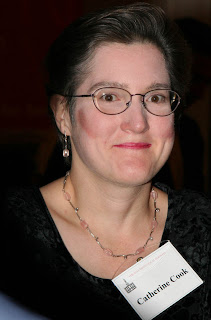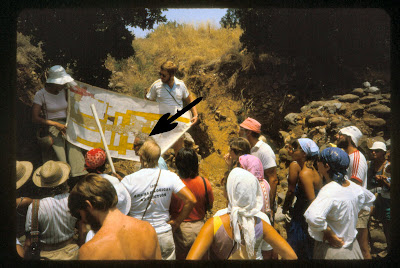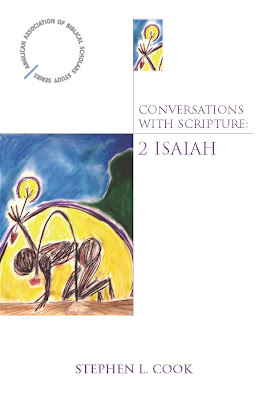Monday, September 29, 2008
Sunday, September 28, 2008
Ed Hall Retires as Vice President for Institutional Advancement
Here's a photo (courtesy of Alix Dorr, seminary photographer) of Catherine at the gala dinner Thursday evening honoring Ed Hall:

Here is an excerpt from the VTS Press Release (click here) on Ed's retirement: Virginia Theological Seminary celebrated the distinguished service of Edwin King Hall [Thursday] night at a gala dinner that included the Seminary faculty and staff members, and Hall’s family and friends. Hall, who currently serves as Vice President for Institutional Advancement, will retire from his position on September 30, 2008. Hall’s tenure with the Seminary began in November of 1995 when he served as a member of the Seminary’s Board of Trustees and Finance Committee, and was Co-Chair of the Strategic Planning Committee—all while working as Staff Director of the Senate Foreign Relations Committee. Later, Hall felt called to leave Capitol Hill and offer his service to a ministry that reflected his deeply held values and faith. In August 2002, under the former deanship of the Very Rev. Martha J. Horne, Hall began work at VTS heading the Office of Institutional Advancement.

Here is an excerpt from the VTS Press Release (click here) on Ed's retirement: Virginia Theological Seminary celebrated the distinguished service of Edwin King Hall [Thursday] night at a gala dinner that included the Seminary faculty and staff members, and Hall’s family and friends. Hall, who currently serves as Vice President for Institutional Advancement, will retire from his position on September 30, 2008. Hall’s tenure with the Seminary began in November of 1995 when he served as a member of the Seminary’s Board of Trustees and Finance Committee, and was Co-Chair of the Strategic Planning Committee—all while working as Staff Director of the Senate Foreign Relations Committee. Later, Hall felt called to leave Capitol Hill and offer his service to a ministry that reflected his deeply held values and faith. In August 2002, under the former deanship of the Very Rev. Martha J. Horne, Hall began work at VTS heading the Office of Institutional Advancement.
Saturday, September 27, 2008
Dr. Avraham Biran, 23 October 1909 – 16 September 2008
I first met Dr. Biran in the summer of 1983 as part of a dig-group from Tel Hesi that visited Tel Dan. Here is a photo that I took of him at that time (click to englarge; I've added a black arrow to point Biran out). He's pointing to a map of Dan, telling us about Dan's city wall and outer gate, around which we are all standing. The pottery dated what we were seeing to the 10th - 9th centuries BCE. Within the gate structure, you could see the benches where the city elders met.


It was long after this visit that Biran's dig found the now famous Tel Dan inscription at this site, demonstrating the historicity of the Davidic dynasty in Judah. You could read about Biran's life and some of his memories of all the digging at Dan by clicking here. Also, check out John Hobbins' comments on his blog: click here.
Thursday, September 25, 2008
Millennium Development Goals Blogging Day

Powered By Ringsurf
Today, world leaders gather in New York to chart progress on the Millennium Development Goals -- 8 goals agreed to by the world's nations in 2000 that represent the largest concerted effort ever to end extreme poverty (click here for info.). We're far behind on meeting these goals by the target date of 2015 ... and most of the rich nations of the world (the U.S. included) are not keeping the promises we made in aid, trade, and debt relief.
Monday, September 22, 2008
Electronic Leningrad Codex Free On-Line
What is especially interesting about this website is that you can turn on color-markings of the Hebrew to show the sources of the Pentateuch (see the sample image below [click to enlarge] from the story of Joseph and the Dream-Coat). Click here for The Unicode/XML Westminster Leningrad Codex. The site gives the entire Hebrew Bible (with the accents) from the electronic version of the Leningrad Codex maintained by the J. Alan Groves Center for Advanced Biblical Research.


Sunday, September 21, 2008
Tuesday, September 16, 2008
2 Isaiah Volume Now Available
Now in stock and available for purchase, only $13. Click here; come on, anyone can afford $13!

"This is precisely the kind of biblical scholarship the church needs: integrating fresh research with profound spiritual and theological insight. With an eye to the saints, ancient and modern, Stephen Cook shows how Isaiah calls us to surrender ourselves, with courageous humility, and thus find ourselves, with dizzying joy." -- Ellen F. Davis, Professor of Bible and Practical Theology, Duke Divinity School
Paperback: 144 pages
Publisher: Morehouse Publishing (September 1, 2008)
Language: English
ISBN-10: 081922149X
ISBN-13: 978-0819221490
update: VTS press release available--click here

"This is precisely the kind of biblical scholarship the church needs: integrating fresh research with profound spiritual and theological insight. With an eye to the saints, ancient and modern, Stephen Cook shows how Isaiah calls us to surrender ourselves, with courageous humility, and thus find ourselves, with dizzying joy." -- Ellen F. Davis, Professor of Bible and Practical Theology, Duke Divinity School
Paperback: 144 pages
Publisher: Morehouse Publishing (September 1, 2008)
Language: English
ISBN-10: 081922149X
ISBN-13: 978-0819221490
update: VTS press release available--click here
Monday, September 15, 2008
One-Day Event: The Bible and Politics

This announcement came in from the SBL: The Society of Biblical Literature partners with Lancaster Theological Seminary in Lancaster, PA for a one-day series of lectures by biblical scholars on how politics affects the Bible and the Bible affects politics.
Saturday, September 27, 2008 - 09:30 AM - 03:30 PM
Engaging the Bible: The Bible and Politics
Engaging the Bible: The Bible and Politics
Our goal is to gather pastors, scholars, and laypersons to study and reflect on the Bible and its use in their professional, congregational, and intellectual lives.
We hope to address questions such as:
· How were the bible writers responding to the politics of their times?
· How can religious leaders best engage the political process while remaining true to their calling?
· What does biblical theology tell us about political engagement?
Our speakers will include:
We hope to address questions such as:
· How were the bible writers responding to the politics of their times?
· How can religious leaders best engage the political process while remaining true to their calling?
· What does biblical theology tell us about political engagement?
Our speakers will include:
Ron Sider, Palmer Theological Seminary, "Toward an Evangelical Political Philosophy" Professor Sider will describe his methodology for moving from biblical material through careful socio-economic analysis and illustrate how he develops the resulting political philosophy.
Julia O’Brien, Lancaster Theological Seminary
Cynthia Briggs Kittredge, Episcopal Seminary of the Southwest “Comforting or Afflicting? Teaching and Preaching the New Testament in Election Season”
Prof. Kittredge will talk about the challenge of interpreting the language of empire and democracy in scripture and culture.
Fernando Segovia, Vanderbilt Divinity School.
This event is free and open to the public, with lunch provided at no cost. Registration is required in advance. To register, please contact Rikki Jones at rjones@lancasterseminary.edu or 1-800-393-0654, ext. 158. For more information, please contact Dr. Bruce Epperly at bepperly@lancasterseminary.edu or ext. 159.
Location:
Santee Chapel
Contact Information:
Contact: Rikki Jones
Email: rjones@lancasterseminary.edu
Phone: 1-800-393-0654, ext. 158
Friday, September 12, 2008
Free Online Yale Course: Introduction to the Old Testament with Christine Hayes

Now available, including video, audio, and lecture transcripts: An entire introduction to the Hebrew Bible / Old Testament as taught to undergaduates by Christine Hayes, the Robert F. and Patricia Ross Weis Professor of Religious Studies in Classical Judaica at Yale. She received her Ph.D. from University of California, Berkeley in 1993. A specialist in talmudic-midrashic studies, Hayes offers courses on the literature and history of the biblical and talmudic periods. To access all the online materials, click here.
Thursday, September 11, 2008
Joseph's Dream Coat (Genesis 37:3)

The exact nature of Joseph's special tunic (Gen 37:3) may never be decided. Of course, many scholars now go with "a long robe with sleeves" (see NRSV, REB, NAB), understanding the Hebrew term פס in a literal sense of "flat of hand or foot," so that the tunic would be one reaching palms and soles. I myself am skeptical. Prof. Chris Heard in a post some time ago remarked that this reading would make Joseph something of an objectionable figure, who was in a special category exempt from hard work. Chris wrote, "Joseph’s כתנת הפסים, then, marks—in its context in Genesis 37—a kind of exemption from the labor to which his brothers were otherwise subject." To me, Joseph is less of a spoiled brat in the story than a young, naive, and unpopular figure, who shows himself completely faithful to his father, Jacob.
The appearance of the tunic on the central (bending) figure in the upper panel of the image above suggests one of the other major translation options for Gen 37:3, i.e., a tunic with varied pieces, panels, or bands (other possible senses of פס) of (multicolored?) fabric (cf. the LXX rendering). The well-known Egyptian wall painting is from the tomb of Khnumhotep III at Beni Hasan, a 19th century image. The figure with the special tunic is the leader of the caravan of hyksos/asiatics bringing eye-salve into Egpyt for trade, a ruler named Ab-Sha. What strikes me about Ab-Sha and his tunic is that the brightly colored garment fit for a leader here is not understood as anything incompatible with labor, at least the labor of directing animals in a trade caravan. As with the other caravan members, some of whom have no top on at all, his arms appear free to move and work.
The kind of special tunic of Joseph is worn by one other figure in Bible, the king's daughter Tamar in 2 Samuel 13. As R. E. Freidman has argued, the two tunics (Joseph's and Tamar's) may well form parts of one story, one large interconnected source/narrative. The tunics may symbolize the same thing in both Genesis and 2 Samuel. Freidman writes, "It is hardly coincidental that the two people who wear a coat of many colors in the Bible are both victims of violence by their brothers, and that both coats are torn. The significance of the coat, therefore, is as a symbol of injustice among siblings." It appears to me that a theme of this large source/narrative is God's oracle/dream/providence sustaining itself despite human/sibling rivalry, jealousy, and violence. The theme is better supported if the coat signifies victimization rather than someone living a spoiled life or actually putting on airs.
Wednesday, September 10, 2008
The Angel of the Akedah at Chartres Cathedral
I often lecture on the representation of Genesis 22, the Near Sacrifice of Isaac, in Jewish and Christian art, where it has such central significance. The extraordinary image of the Akedah at Chartres Cathedral on the north porch, central bay, is one of my favorites. Until now, however, I have not been able to find a good image of the angel, although I've always pointed out that he is in the space above Melchizedek's head to the left of Abraham, and in the line of sight of both the ancestor and his son, Isaac.

I'm very pleased to have finally found a great image of the angel! Click the image below to enlarge. Pretty neat, no?


I'm very pleased to have finally found a great image of the angel! Click the image below to enlarge. Pretty neat, no?

Update (3/2/2024), Detail photo courtesy Zsuzsanna Sóti, Hungary
Tuesday, September 09, 2008
Monday, September 08, 2008
How to Speak from a Lectern....Not (Humor)
Heading to my classroom today, I saw this cartoon from CartoonChurch on a board, so I looked it up online (click here) to post for you all, my readers. Of course, this is exactly what I try to get seminarians not to do in the lectern...


Friday, September 05, 2008
Bibliographic Resources for Hebrew Reading and Exegesis

Like many of us, I've recently revised my syllabi for the new fall term. Below is my lightly annotated list of reference books helpful for students in my second-year Hebrew Reading and Exegesis class. Do any of you have comments, corrections, or additions to suggest? These are most welcome. Thanks!
Bibliographic Resources for Hebrew Reading and Exegesis
Lexical Tools:
Brown, Francis; S. R. Driver & Charles A. Briggs, A Hebrew and English Lexicon of the Old Testament (BDB) Oxford: Clarendon Press, 1951. You'll probably remember the features of this work from your introductory Hebrew course. A less expensive edition of the work is available from Hendrickson. It includes some additional “helps,” but the print quality is not as high as the Oxford edition. REF PJ4833.G4 1980
Holladay, W. L. (ed.), A Concise Hebrew and Aramaic Lexicon of the Old Testament Grand Rapids, Michigan: Eerdmans, 1971. This is an affordable, English, abridged version of the German Köhler-Baumgartner lexicon (see next entry). Though handy and portable, it is not as comprehensive as BDB and not as useful for Hebrew exegesis. REF PJ4833.H733
Köhler, L., W. Baumgartner, and Johann Jacob Stamm et al., The Hebrew and Aramaic Lexicon of the Old Testament (HAL-OT), 3 vols. Leiden: E. J. Brill, 1994-2000. A new, unabridged, English translation of Köhler-Baumgartner, with revisions and updating. Draws on more recent comparative Semitic data than BDB. REF PJ4833.K79 (vols. 1-3)
Feyerabend, Karl, Langenscheidt's Pocket Hebrew Dictionary to the Old Testament New York: Langenscheidt, 1961. Arranged alphabetically according to basic lexical form, rather than roots (contrast BDB). Complete, but only basic, concise definitions. REF PJ4833 .F434
Einspahr, Bruce, Index to Brown, Driver & Briggs' Hebrew Lexicon Chicago: Moody Press, 1976. An aid that can facilitate use of BDB, especially for the beginning student. N.B.: This should be used as a last resort only and not as a crutch. PJ4833.B683 G4
Davidson, Benjamin, The Analytical Hebrew and Chaldee Lexicon Grand Rapids: Zondervan, 1978. Lists every word and inflection of the Hebrew Bible in alphabetical order and gives its grammatical analysis and three-letter root. Don't you wish you had known about this book in Introductory Hebrew! ☺ N.B.: Please use this reference only as a last resort and not as a crutch. Otherwise, you will stunt your linguistic growth. REF PJ4833.D3 1970
Botterweck, G. Johannes and Helmer Ringgren (eds.), Theological Dictionary of the Old Testament (TDOT) (tr., J. T. Willis et al.; multiple volumes) Grand Rapids, Michigan: Eerdmans, 1974- . An unabridged translation of Theologisches Wörterbuch zum Alten Testament. Discusses key Hebrew and Aramaic words in depth. The project is not yet complete, but close to it. If the word study you need is not in TDOT, you should also check G. Kittel and G. Friedrich (eds.), Theological Dictionary of the New Testament (TDNT), which contains studies of the Hebrew terms behind the key Greek words of the New Testament. REF BS440.B751 (vols. 1-15 currently available).
Clines, David J. A. (ed.), The Dictionary of Classical Hebrew Sheffield: Sheffield Academic Press, 1993- . A new, multi-volume Hebrew dictionary project. It attempts to deal with all extant texts of Classical Hebrew, not just those found in the Bible; it is oriented by modern linguistic theory, e.g., it focuses on the use of words rather than on their translation equivalents; it is arranged alphabetically; and it uses inclusive language. So far, the project is complete through vol. 6, Samekh-Pe. REF PJ4833 .D554 (6 vols. currently available).
Guides to Hebrew Syntax:
Williams, Ronald J., Hebrew Syntax: An Outline. Second edition. Toronto ; Buffalo : University of Toronto Press, 1976. An old seminary stand-by, outlining Hebrew syntax in concise, numbered sections. A useful quick-reference. The specialized (idiosyncratic?) terminology will take some getting used to. Look closely at the examples given in each section and at how the English translation brings out the syntax in each case. PJ4701.W726 1992 [update: there is a new third edition (2007) updated by John C. Beckman, which keeps the same structure and section numbers but expands the discussions, subdivides some of the sections, and adds cross-refrences to the major grammars. This looks like the one to buy now: ISBN: 0802094295 (click here)]
Arnold, Bill T., and John H. Choi, A Guide to Biblical Hebrew Syntax Cambridge: Cambridge University Press, 2003. Intended as an intermediate help for Hebrew students, giving them affordable access to scholarly advances in understanding the topic. PJ4701 .A752 2003
See, importantly, Waltke & O’Connor below.
Reference Grammars:
Gesenius, W., (ed. E. Kautzsch and A. E. Cowley) Gesenius’ Hebrew Grammar (GKC) Oxford: Oxford University Press, 1910. This is the standard Hebrew reference grammar in English. It is much more detailed than any introductory, “teaching” grammar (including Davidson, Weingreen, or Kittel). Although issued in this basic form at the start of the century, it remains of immense value since it is primarily "descriptive." It is perhaps most accessible through the excellent scripture index. If you encounter a difficult phenomenon in the Hebrew of a verse you are working on, more often than not the verse will be indexed in GKC. REF PJ4564.G389
Jöuon, P. (tr. and revised, T. Muraoka) A Grammar of Biblical Hebrew (3 parts in 2 volumes; Subsidia Biblical 14 / 1 & II) Rome: Editrice Pontificio Istituto Biblico, 1996. A comprehensive and very helpful reference grammar of Biblical Hebrew, originally available only in the original French. The Semitic linguist, T. Muraoka not only translated the work into English but also revised it substantially and expanded it in light of modern advances. There is an extensive index of biblical passages at the end of vol. II. (I am told that there is a newer edition of this available, but I have not seen it.) PJ4567.J87 1991 (2 vols.). [update: okay, the 2006 edition has an ISBN of 8876536299; I've checked several on-line bookstores now, and I just don't find this available in print; please correct me if I'm wrong; however, I just checked my computer and Bible Works 7.0 is using this latest edition! second update: this is also now available as a pre-order from logos: click here]
Waltke, Bruce, and Michael P. O’Connor, Introduction to Biblical Hebrew Syntax Winona Lake, Ind.: Eisenbrauns, 1990. Now a standard tool for reading and understanding Hebrew at a level beyond the beginner. Many find the prose turgid, but the volume is really indispensable for tackling the more complex levels of the language. Many argue that Joüon-Muraoka, van der Merwe, along with the other comparable works available, just don't hold a candle to Waltke O'Connor in terms of depth and helping one to understand the Hebrew. REF PJ4707.W237
Wednesday, September 03, 2008
Kol HaNNeshama(h) (Psalm 150:6) MP3 Free Download
This mp3 music file is truly worth downloading! Nice beat; a great round! VTS's own Adam Thomas performed and recorded this song, based on the Hebrew of Psalm 150:6, for my Hebrew class last year. Thank you Adam! To download, right click here and "save as."
כֹּל הַנְּשָׁמָה תְּהַלֵּל יָהּ הַלְלוּ־יָהּ

כֹּל הַנְּשָׁמָה תְּהַלֵּל יָהּ הַלְלוּ־יָהּ

Monday, September 01, 2008
Pete Enns' Resignation from WTS

I thought I should update the story I have been following on the controversy over Old Testament scholar, Dr. Pete Enns (click here). On August 1st, Pete resigned from WTS. A joint letter issued by the administration and by Pete stated that the two sides had reached a mutual agreement that allowed him to leave (click here). I am sure the agreement will not be made public, and that it will prevent either side from further comment. For an article on this at Philly.com, click here. I do not yet know where Pete will go to continue his career in Old Testament, but I sure wish him well.


